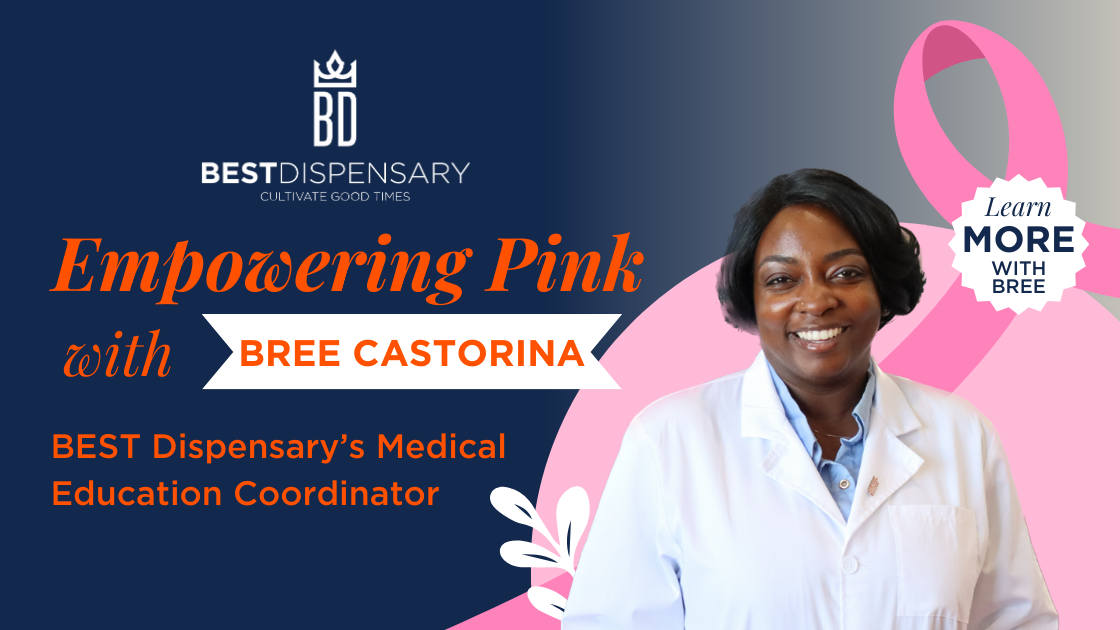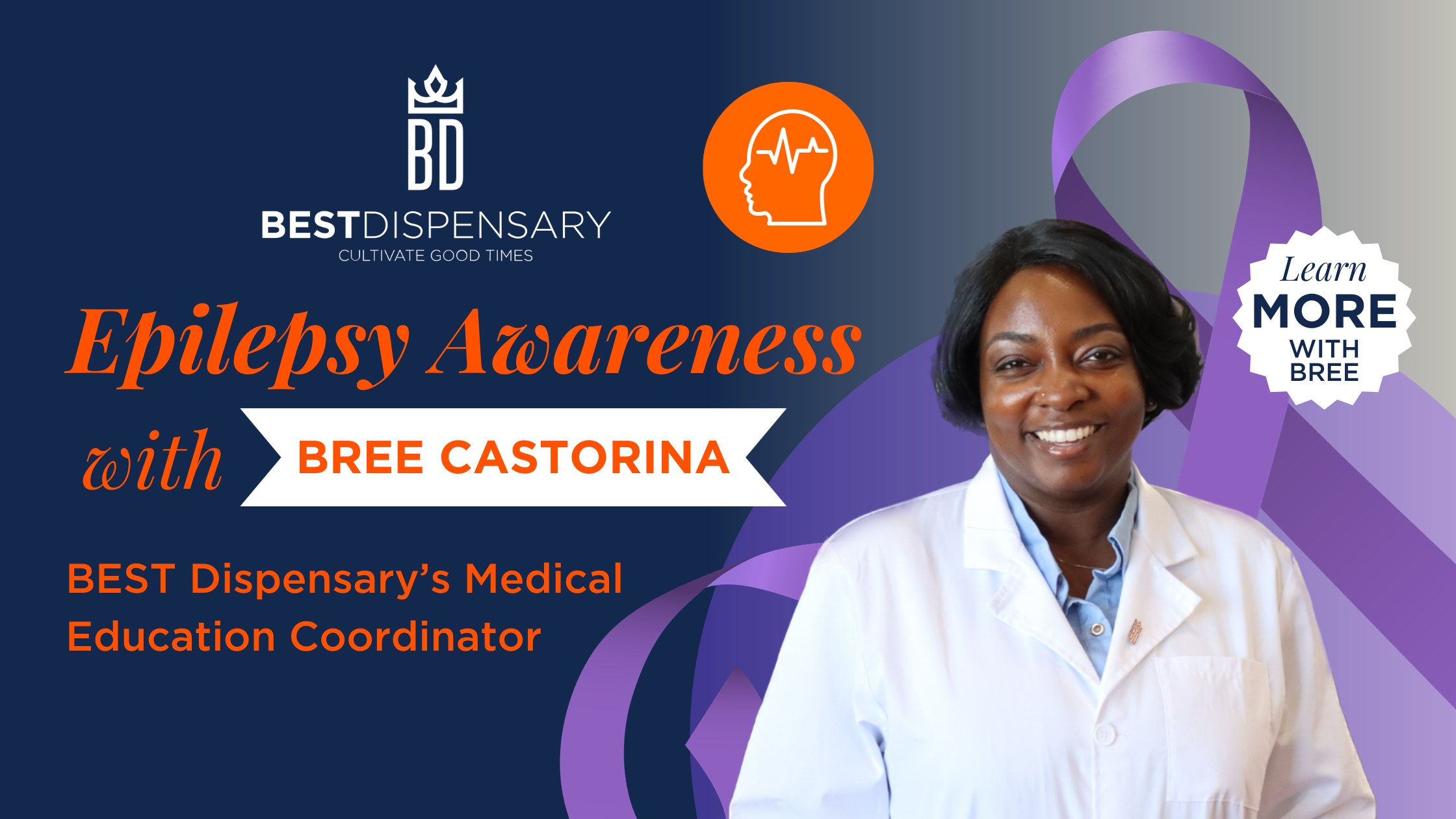October is Breast Cancer Awareness Month, a time for learning and raising awareness. Here we’ll explore some causes, risk factors, and types of breast cancer. We’ll also discuss how cannabis compounds like cannabinoids and terpenes may help manage its symptoms and treatment side effects. We hope to contribute to the fight against breast cancer by sharing this information.
Understanding the Roots of Breast Cancer
Breast cancer’s origin is complex, often starting when healthy breast cells go awry, especially in milk ducts. It is often triggered by the BRCA1 and BRCA2 Mutations, which are inherited mutations. These genes significantly increase the risk of breast cancer.
The risk factors also include:
- Early periods
- Late menopause
- Hormone therapy
- Exposure to radiation
Having a first-degree relative (parent, sibling, child) who has had breast cancer can elevate your risk. It’s important to inform your doctor about this family history and adhere to the recommended early detection protocol.
As with anything, a healthy lifestyle matters, with factors such as obesity, alcohol, inactivity, and childbirth playing a role.
Hormones and Their Role
Hormones, particularly estrogen, have a substantial impact, especially elevated estrogen levels, which can raise your risk. Hormone replacement therapy, commonly used to alleviate menopausal symptoms, may lead to unexpected effects. Staying well-informed is of utmost importance.
Different Types of Breast Cancer
There are various types of breast cancer which encompasses a range of distinct forms:
- Luminal A: Thrives on estrogen and progesterone, often slow-growing, and typically lacks the HER2 protein.
- Luminal B: Also depends on estrogen and progesterone but grows faster and may have higher HER2 levels.
- Triple Negative: Not reliant on estrogen, it’s invasive and challenging to address.
- HER2 Enriched: A rarer type where cells grow rapidly due to too many HER2 gene copies.
Recognizing Symptoms
Early detection is crucial. Watch for signs like:
- Breast lumps
- Swollen lymph nodes
- Nipple changes
- Discoloration
- Pain
- Swelling.
Cannabis and Breast Cancer Treatment
Breast cancer is conventionally treated with surgery, chemotherapy, and radiation, which can lead to side effects. It’s essential to understand these options, discuss cancer treatments and cannabis use thoroughly with your doctor, and consult a Cannabis Wellness Advisor before using cannabis to manage symptoms and side effects.
The Potential of Cannabinoids and Terpenes
Cannabinoids and terpenes, found in cannabis, show promise in managing breast cancer symptoms and side effects. While not a cure, they can play an essential role.
The Power of Cannabinoids
- THC: Some studies showed that THC slows the growth of certain breast cancer cells, inactivates HER2, relieves pain, reduces inflammation, stimulates appetite, manages neuropathic pain, fatigue (in small doses) and stomach issues, and eases nausea.
- CBD: Can induce breast cancer cell death, reduce painful inflammation, and effectively manage neuropathy and stomach issues.
- CBDA: stopped breast cancer cells from spreading in lab tests, offering potential treatment benefits. A study also found it to be a more potent antiemetic than CBD.
- CBG: synergizes with THC to stimulate appetite and effectively manage stomach issues.
- THCa: may alleviate nausea and vomiting to a lesser extent compared to other cannabinoids.
The Role of Terpenes
In cannabis, terpenes not only contribute to the plant’s distinctive smell and taste but also have potential therapeutic properties and play a significant role in the entourage effect, which is the synergistic interaction between cannabinoids (such as THC and CBD) and terpenes. Here are some common cannabis terpenes we refer to when assisting cancer patients when selecting cannabis medications:
- Beta-Caryophyllene: one study found synergistic anti-cancer effects with chemotherapy. Other benefits include appetite stimulation, improved quality of life, and relief from various health issues like stomach problems and joint pain.
- Linalool: Research unveiled synergistic anti-cancer effects with chemotherapy, alongside benefits like appetite stimulation, enhanced life quality, and relief from stomach issues and pain.
- Limonene: Shown to reduce cell cycle-related genes, reduces inflammation, prevents nausea, boosts appetite, fights fatigue, improves mood, eases muscle and joint pain, and protects against bone fractures.es life quality.
- Myrcene: can encourage the prevention of cancer spread, alleviate pain and inflammation, combat nausea and vomiting, and boost appetite.
- Geraniol: provides anti-inflammatory properties and relief from nerve pain, preventing diarrhea in a range of health issues.
Remember, consult with a healthcare professional before using these compounds in your breast cancer treatment. They complement conventional treatments and should be personalized to your unique needs. Let’s continue the fight against breast cancer! 💖 #BreastCancerAwareness
Disclaimer
The information provided in this online article is intended for general informational purposes only. While we diligently strive to ensure the accuracy and reliability of the information presented, it is not a replacement for professional advice. The content may draw upon findings from various research sources, yet it should not be the sole basis for making significant decisions. We strongly encourage our readers to independently verify any information and seek expert guidance when necessary.
We want to clarify that we do not endorse or assert the accuracy or appropriateness of the information contained within the sources cited in this online article. Any reliance you place on such information is done so at your own discretion and risk.
Our commitment is to maintain the information’s currency and correctness. However, we make no guarantees or warranties of any kind, whether express or implied, regarding the completeness, accuracy, reliability, suitability, or availability of the content contained within the article, its associated products, services, or related graphics, for any particular purpose.
Under no circumstances will we be held liable for any loss or damage, including but not limited to indirect, consequential, or any other kind of loss or damage, arising from data loss or profit loss, stemming from the use of this online article. Your use of this article signifies your acknowledgment and acceptance of these terms.
Citations
- Dobovišek, L., Krstanović, F., Borštnar, S., & Debeljak, N. (2020). Cannabinoids and Hormone Receptor-Positive Breast Cancer Treatment. Cancers, 12(3), 525. https://doi.org/10.3390/cancers12030525
- Journal of Pharmacology and Experimental Therapeutics September 2006, 318 (3) 1375-1387; DOI: https://doi.org/10.1124/jpet.106.105247
- Takeda, S., Okajima, S., Miyoshi, H., Yoshida, K., Okamoto, Y., Okada, T., Amamoto, T., Watanabe, K., Omiecinski, C. J., & Aramaki, H. (2012). Cannabidiolic acid, a major cannabinoid in fiber-type cannabis, is an inhibitor of MDA-MB-231 breast cancer cell migration. Toxicology letters, 214(3), 314–319. https://doi.org/10.1016/j.toxlet.2012.08.029
- Rock, E. M., Limebeer, C. L., Pertwee, R. G., Mechoulam, R., & Parker, L. A. (2021). Therapeutic Potential of Cannabidiol, Cannabidiolic Acid, and Cannabidiolic Acid Methyl Ester as Treatments for Nausea and Vomiting. Cannabis and cannabinoid research, 6(4), 266–274. https://doi.org/10.1089/can.2021.0041
- Analgesic, Appetite-Stimulating, and Subjective Effects of Cannabigerol Administered Alone and in Combination with Delta-9-Tetrahydrocannabinol.” (n.d.). Center for Medicinal Cannabis Research, University of California, San Diego. Retrieved from https://www.cmcr.ucsd.edu/index.php/background/studies/active-studies/274-analgesic-appetite-stimulating-and-subjective-effects-of-cannabigerol-administered-alone-and-in-combination-with-delta-9-tetrahydrocannabinol#:~:text=Specifically%2C%20CBG%20may%20increase%20the,consequences%20of%20higher%20THC%20dose
- Jean Legault, André Pichette, Potentiating effect of β-caryophyllene on anticancer activity of α-humulene, isocaryophyllene and paclitaxel, Journal of Pharmacy and Pharmacology, Volume 59, Issue 12, December 2007, Pages 1643–1647, https://doi.org/10.1211/jpp.59.12.0005
- Raffaella Ravizza Marzia B. Gariboldi Roberta Molteni Elena Monti. (2008), Linalool, a plant-derived monoterpene alcohol, reverses doxorubicin resistance in human breast adenocarcinoma cells, 625-630, spandidos-publications.com/or/20/3/625
- Miller, J. A., Lang, J. E., Ley, M., Nagle, R., Hsu, C. H., Thompson, P. A., Cordova, C., Waer, A., & Chow, H. H. (2013). Human breast tissue disposition and bioactivity of limonene in women with early-stage breast cancer. Cancer prevention research (Philadelphia, Pa.), 6(6), 577–584. https://doi.org/10.1158/1940-6207.CAPR-12-0452
- Lee, JH., Lee, K., Lee, D.H. et al. Anti-invasive effect of β-myrcene, a component of the essential oil from Pinus koraiensis cones, in metastatic MDA-MB-231 human breast cancer cells. J Korean Soc Appl Biol Chem 58, 563–569 (2015). https://doi.org/10.1007/s13765-015-0081-3


